Recent Acquisitions
On this page you'll find my latest acquisitions.
This way you can quickly browse through my recently acquired objects without having to browse through all the various categories.
After some time, each object in 'Recent Acquisitions' will be moved to their specific category.
Latest update: Recent Acquisitions; November 5, 2025.

Japanese Early Overglaze Enamelled wares 1660-1680 & Japanese Blue and White wares 17th Century - Other wares
Objects 2012666 & 2012669
Two Jars
Japan
1660-1680
2012666 (Early enamelled jar) Height with cover 160 mm (6.30 inch), height without cover 137 mm (5.39 inch), diameter of mouthrim 71 mm (2.80 inch), diameter of footring 59 mm (2.32 inch), weight with cover 494 grams (17.43 ounce (oz.)), weight cover 37 grams (1.31 ounce (oz.))
2012669 (Underglaze blue jar) Height with cover 140 mm (5.51 inch), height without cover 111 mm (4.37 inch), diameter of mouthrim 61 mm (2.40 inch), diameter of footring 46 mm (1.81 inch), weight with cover 321 grams (11.32 ounce (oz.)), weight cover 67 grams (2.36 ounce (oz.))
Oviform jars on footring; short wide neck. The original lid on object 2012666 is missing and has been replaced by a 20th-century steel cover. Decorated in underglaze blue (2012669) and early enamels (2012666) with various flowering plants, birds a butterfly and a moth. Round the foot and neck and on the shoulder, decorative key-fret, cell-diaper and spearhead borders between underglaze blue lines.
Small jars of this shape and design are common. It is interesting to know how the flying bird and the large flowers still evoke the river scenes with waterfowl seen on Chinese kraak porcelain, while the bird sitting on a branch is related to the depiction on Kakiemon porcelain. (Jörg 2003/1, p.61, cat. 45)
Impey states that the pattern on this jar can only be found on jars of this shape on two sizes in enamels and is closely paralleled in blue-and-white jars of similar rounded shape. These type of covered jars seem to have come two sizes and and two varieties, one with and one without underglaze blue diving lines. According to Imey it was coloured jars of this type that form the category, the 'Dark polychrome group' suggested by Impey himself. (Impey 2002, p.64, cat. 48 & 49)
For identically shaped and decorated in early enamels jars with the dividing underglaze bue lines, please see:
- Eastern Ceramics and other works of art from the collection of Gerald Reitlinger, (Ashmolean Museum, Oxford 1981), p.82, cat 214.
- Japanese Porcelain, (S. Jenyns, Faber & Faber, London / Boston, 1979), cat. 32b.
For identically shaped and decorated in early enamels jars without the dividing underglaze bue lines, please see:
For identically shaped and decorated in early enamels jars with Dutch Silver-gilt mounts with a Chinese cover, please see:
- Chinesisches und japanisches Porzellan in europäischen Fassungen, (D.F. Lunsingh Scheurleer, Verlag Klinkhardt & Biermann, Braunschweig,1980), p.415, Abb. 464.
- Porcelain for Palaces. The Fashion for Japan in Europe 1650-1750, (J. Ayers, O. Impey & J.V.G. Mallet, Oriental Ceramic Society & The British Museum, London 1990), p.122, cat. 80.
- Japanese Export Porcelain. Catalogue of the Collection of the Ashmolean Museum, Oxford, (O. Impey, Hotei Publishing, Amsterdam, 2002), p.67, fig. 49.
For identically shaped and decorated in underglaze blue, please see:
Conditions:
2012666: Perfect.
2012669: A frit and a firing flaw to the rim of the jar and a frit to the rim of the cover.
References:
Lunsingh Scheurleer 1971, cat. 160a & 160b
Lunsingh Scheurleer 1980, Abb. 464
Price: Object 2012666 € 3.500 Currency Converter
Price: Object 2012669 € 1.500 Currency Converter

Japanese Kakiemon / Kakiemon-style wares - Kakiemon wares
Object 2012657
Covered jar
Japan
c.1680
Height with cover 320 mm (12.60 inch), height without cover 256 mm (10.08 inch), diameter of mouthrim 125 mm (4.92 inch), diameter of footring 114 mm (2.49 inch), weight with cover 2,295 grams (80.95 ounce (oz.)), weight cover 261 grams (9.21 ounce (oz.))
Ovoid jar on footring, low neck, wide spreading mouthrim. Domed cover with flattened conical knob. Decorated in underglaze blue, iron-red, yellow, green, and black enamels with flowering prunus, peony and chrysanthemum plants growing from rockwork. On the shoulder three borders, one with coin shaped ornaments in underglaze blue, one with a diaper pattern in iron-red and a karakusa scroll in underglaze blue. Round the neck a border with upturned spiky lotus leaves. The cover is decorated en suite. On the base the remains of a half ripped off rectangular paper label with the handwritten text in black ink: 'Kakiemon Jar 17'c'.
In 1685, Andreas Cleyer arrived on Deshima as opperhoofd, bringing with him a new order for porcelain, including '36 of the largest pots to be found, with lids, the ones that are known in our fatherland as Atjeh pots, it must be arranged that there are half a dozen of each, large and with flowers',{'36 vande grootste potten, die te bekomen sijn, al was 't oock meer met hare decksels, welckdat hier voren op den vaderlandsen eijsch aatciar potten genoemt dag dient gelet off besorgt dat ijder halff dozijn eenderhande van groote en bloem sijn'}. Further: 'Everything of the best and finest work, furthermore, painted in blue, but no red, much less green, since here and in our fatherland these colours are not appreciated as before on porcelain.' {'Alles van het fijnste en beste werck mitsgader blau geschildert,maar geen rood, veel minder groen, derwijle die couleuren op het porceleijn present, hier ende in 't vaderland geensints vande vorige estime sijn'}. The comment 'no red' {'maar geen rood'} is puzzling - does it really mean that there should be no red at all? 'Much less green' {'veel minder groen'}, however, suggests that overglaze decoration should not be completely absent: to my mind it means a desire for more underglaze blue in combination with relatively few overglaze colours. If we put the large pots of this period alongside one another, then it is evident that on the lidded jars presumed to be earlier, red and green dominate the decoration, while on the later examples, the foliate and floral work is primarily carried out in underglaze blue, with hardly any red and much less green. This is not precisely a succession of style, but rather a shift from pieces with overglaze only to a larger proportion of pieces with underglaze blue as well. Another indication for a difference in dating is the form of the footring, which is first round but later has a straighter shape, as it also does on 18th-century pieces.
This shift is not so surprising if we consider that the first coloured pieces started to arrive in Europe halfway through the 1650s. After 30 years, something new was needed. It is likely that alongside the overglaze-only objects, more pieces gradually appeared that combined underglaze blue with other colours. These less exuberant pieces exuded a more modest, refined feeling of luxury: after the initial celebration of colour, an era of more subtlety and balance in the decoration followed. (Fitski 2011, pp.19-20)
For an identically shaped, sized and decorated, covered jar in the collection of The Fitzwilliam Museum Cambridge, please see:
In their time these covered jars were already cherished as objects of great value even to the extent that after a jar was broken, a completely new Dutch Delftware jar (marked: CF. An unknown potter's, or factory mark) copied after the Japanese original) was ordered. For this copied Dutch Delftware jar with its original Japanese cover, please see:
- Porcelain for Palaces. The Fashion for Japan in Europe 1650-1750, (J. Ayers, O. Impey & J.V.G. Mallet, Oriental Ceramic Society & The British Museum, London 1990), p.192, cat. 181.
- The collection of Oriental ceramics from the Groninger Museum, objectnumber 2003.0110.
Conditions:
Jar: A firing hairline.
Cover: Restored.
References:
Ayers, Impey & Mallet 1990, cat. 181
Groninger Museum, Objectnumber 2003.0110
The Fitzwilliam Museum Cambridge, Accession Number: JL5 & A-1984
Price: Sold.

Japanese Early Overglaze Enamelled wares 1660-1680
Object 2012659
Dish
Japan
1660-1670
Height 63 mm (2.48 inch), diameter of rim 320 mm (12.60 inch), diameter of footring 119 mm (4.69 inch), weight 1,297 grams (45.75 ounce (oz.))
Dish on footring, spreading rim. On the base a single spur-mark. Decorated in early enamels in a Chinese kraak style, the outlines and details in black with rockwork, grasses and flowering plants encircled by two red circles. On the sides and rim eight broad panels filled with flowering plants and auspicious symbols separated by eight narrow panels filled with a knotted ribbon in between a scale pattern. On the reverse tree sprays of leaves and flowers. Three red circles round the foot and one on the base.
Japanese documents, kiln-site excavations and surviving pieces seem to confirm that Arita potters started making porcelain with an enamelled decoration in the mid-1640's. Influences of Chinese polychrome porcelain are obvious. Chinese wares had been imported into Japan in some quantity and found a ready market. It is understandable that Japanese potters tried to copy them in order to compete locally. Furthermore, in the mid-1640's, the Japanese must have faced the same problems as the Dutch: Chinese porcelain was no longer easily available due to the civil wars, and the desire for alternatives stimulated production in Arita. Producing polychrome wares required mastering new techniques. Instead of the single firing used for underglaze blue wares, pieces now had to be fired a second time at a lower temperature. It seems that Chinese potters provided the Japanese with the knowledge of decorating in enamels, technically so different from painting in underglaze blue or iron-oxide.
Initially, the Arita potters did not produce for export, but things changed when the Dutch started to buy porcelain in Japan, first privately in the mid-1650's or even earlier, and from 1657 formally through the Dutch East India Company, (Vereenigde Oost-Indische Compagnie, VOC) as well. In their letter of 12 July of that year, the Directors in Amsterdam asked Deshima to send samples of porcelain made in Japan, 'two or three pieces of each kind, to wit, those that are painted with all kinds of colours, blue and otherwise....' Accordingly, the first cargo of Japanese wares the VOC shipped to the Netherlands included many polychrome wares as try-outs, and must have found keen buyers as further shipments for patria contained assortments of enamelled wares as well as underglaze blue porcelain. (Jörg 2003/1, pp.49-51)
This group of enamelled export porcelain was coined 'early enamelled ware' by Impey because of the way their colour schemes and decorations) differed from the later Kakiemon and Imari wares that developed out of this group. They only cover a short period, from 1660 to 1680, and represent the 'early' phase of polychrome ware for export. The enamels are bright and show a strong green, a brownish yellow. a beautiful dark brick-red, a light aubergine and a surprising overglaze blue; outlines are mostly in black. Initially, the enamels were still rather opaque, but they became more transparent in time. The overglaze blue enamel is particularly interesting: it was used occasionally in China on Wanli pieces, but it was not until the end of the 17th century that it became popular on Kangxi famille verte pieces. (Jörg 2003/1, pp.49-51)
Ohashi states that the 'overglaze enamel technique was transferred to Japan from China'. Consequently he says, to enable the second firing, enamelled pieces had a wider footring than underglaze blue shoki-Imari pieces. However, saggars were not yet in use and both body and glaze usually show impurities. Pieces show combinations of enamels with underglaze blue or enamels only. Decorations were initially based on Chinese models, but quickly developed into a Japanese style. (Jörg 2003/1, p.51)
On the early enamelled wares. underglaze blue patterns are confined to circular lines around the foot, shoulder or neck or to a minor part of the composition, thus leaving the enamel painter much freedom. Some pieces do share characteristic elements, for instance, several jars, bottles and ewers show a ground of groups of parallel vertical short lines in a brick-coloured iron-red, indicating water. This device resembles comparable grounds on Chinese Transitional pieces decorated in wucai enamels, from which the idea may have been derived. It is not seen on later Kakiemon or Imari porcelain. (Jörg 2003/1, p.50)
Returning to the early enamelled wares, a special group has to be mentioned. It consists of plates, deep saucers and dishes with an enamelled decoration in kraak style. They closely follow the composition of underglaze blue Chinese models of kraak porcelain with a border of wide and narrow panels and a flowerpot or a river scene with birds in the centre. However they are only painted in overglaze enamels without any underglaze blue. These bright pieces must have been a most attractive replacement for Chinese kraak ware, which had become unavailable, and one would have expected the Dutch to have shipped them to The Netherlands in large quantities. This seems not to have been the case, however, as nearly all the pieces in Dutch collections have an Indonesian provenance. In general, early enamelled wares are noticeably lacking in Dutch museums when compared to more substantial collections in England and Germany. (Jörg 2003/1, p.51)
For other Japanese dishes decorated in early enamels in a Chinese kraak style, please see:
- Eastern Ceramics and other works of art from the collection of Gerald Reitlinger, (Ashmolean Museum, Oxford 1981), p.67, cat. 154.
- Japanese Export Porcelain. Catalogue of the Collection of the Ashmolean Museum, Oxford, (O. Impey, Hotei Publishing, Amsterdam, 2002), p.72, cat. 57.
- Fine & Curious: Japanese Export Porcelain in Dutch Collections, (C.J.A. Jörg, Hotei Publishing, Amsterdam 2003), pp.53-54, cat. 34.
- Dragons, Tigers and Bamboo: Japanese Porcelain and its impact in Europe - The Mac-Donald Collection, (O.Impey, C.J.A. Jörg and C. Mason, Douglas & McIntyre Publishers Inc., Vancouver/Toronto/Berkeley 2009), p.83, Fig. 34.
Condition: A firing flaw and chip to the rim and a hairline to the rim.
References:
Jörg 2003/1, pp.49-51, cat. 34
Impey, Jörg & Mason 2009, p.79 & p.83, Fig. 34
Price: Sold.

Japanese wares with Western Designs 1653-1800
Object 2012663 & 2012664
Two tea bowls and saucers
Japan
1700-1720
2012663
Saucer: Height 22 mm (0.86 inch), diameter of rim 130 mm (5.12 inch), diameter of footring 72 mm (2.83 inch), weight 90 grams (3.17 ounce (oz.))
Tea bowl: Height 43 mm (1.69 inch), diameter of rim 77 mm (3.03 inch), diameter of footring 34 mm (1.34 inch), weight 58 grams (2.05 ounce (oz.))
2012664
Saucer: Height 23 mm (0.91 inch), diameter of rim 129 mm (5.08 inch), diameter of footring 70 mm (2.76 inch), weight 98 grams (3.46 ounce (oz.))
Tea bowl: Height 50 mm (1.97 inch), diameter of rim 75 mm (2.95 inch), diameter of footring 32 mm (1.26 inch), weight 53 grams (1.87 ounce (oz.))
Two tea bowls and saucers on footrings, straight rims. Imari, decorated in underglaze blue, iron-red, black, gold and various other translucent enamel colours with two farmers walking with a leashed water buffalo near a rice field with hills, trees and houses in the background in a central roundel surrounded by a riverscape with mountains, pagodas, houses, flags, clouds and pine trees. Two fishermen sit in a boat on a river and on a rocky riverbank two figures are having a pick nick, besides them on the ground stands a cup and saucer on a footring, a rectangular box with chop sticks and a clearly recognisable bottle with the initials 'FW'. Around the rim a zig-zag lines pattern border. On the reverse three widespread flower sprays. The tea bowls are decorated en suite.
In 'Fine & Curious' an identically decorated saucer is published. On this saucer we see the same scene with the same two fisherman having a pick nick on a rocky riverbank with besides them on the ground a teacup on a footring, a rectangular box with chop sticks and a clearly recognisable bottle with the initials 'FW'. Jörg states that the initials 'FW' could very well indicate the owner or the contents, for example Franse Wijn (French wine). In this context it is interesting to note that parts of an export teaset are known that have an Imari decoration of a scene of two Japanese pick nicking on a rocky riverbank under a tree. The bottle with the initials 'FW' is clearly recognisable. European objects were greatly desired in Japan and such inscribed bottles, regarded as exotic Western objects, may not only have been made for Dutch clients, but also for the domestic market. It is tempting to imagine that they were used for sake instead of wine. (Jörg 2003/1, p.221, cat. 276a)
In his Fine & Curious on page 221, cat. 276 Jörg shows this identically shaped and FW initialled bottle Reproduced from: Fine & Curious. Japanese Export Porcelain in Dutch Collections, (C.J.A. Jörg, Hotei Publishing, Amsterdam, 2003), p.100, cat. 99. This bottle is not included in this sale/offer. (copyright in bibliographic data and images is held by the publisher or by their respective licensors: all rights reserved)
A saucer with a similar decoration is known in the Musée Ariana in Geneva. On Japanese porcelain it is already very rare to see an image of a identifiable type of export porcelain, but the image of such a specific object (the bottle with FW initials) is unique. The scene is traditional and does not refer to the Dutch, Decima or the Dutch East India Company (VOC). The two pick nicking figures are Japanese dressed, so it could be obvious that they drink sake (rice wine), so the bottle is in use as a sake bottle. It could very well be that this scene gives a representation of the habits in use in Japan at that time. Upper class people in Japan have always been interested in exotic ceramics, and it can be read in VOC documents that Delfts Faience and German stone good were given as presents to high officials in Nagasaki and Edo. In that interest fits the use of a Western object like the bottle. Remains the question, are the initials a coincidence or were they ordered? Did the porcelain painter have a 'FW' bottle as an example which he copied as an exotic object or was there a tea service ordered by a Dutchman, for example for the person who also ordered the original 'FW' bottles? This seems not to be very likely because the commande element is so low prominent something not very likely to fit in that time. It is however so that bottles like this were used by Japanese and Europeans to contain alcoholic beverages. (Jörg 1989/1, pp. 396-407)
For identically shaped, sized and decorated tea bowl and saucers in the Ashmolean Museum, Oxford, please see:
Condition:
2012663: A firing flaw to the footring of the tea bowl.
2012664: A firing flaw to the footring of the tea bowl.
References:
Price: Sold.

Japanese Imari 1690-1800
Object 2012662
Vase
Japan
1700-1720
Height 210 mm (8.26 inch), diameter of rim 62 mm (2.44 inch), diameter of footring 75 mm (2.95 inch), weight 709 grams (25.00 ounce (oz.))
Cylindrical vase on footring with narrowing shoulder, wide neck and spreading mouthrim. Imari, decorated in underglaze blue, iron red and gold. Two reserves filled with flowering chrysanthemums, some are moulded in low relief, some leaves are outlined in underglaze blue, reserved on an underglaze blue ground with floral scrolls in gold. The reserves are flanked by lozenge shaped reserves filled with a flower head in iron-red and gold or a golden flower head on an underglaze blue ground. Round the foot and top a band in underglaze blue with floral scrolls in gold. On the shoulder, neck and inside the rim chrysanthemum and lotus scrolls in iron-red and gold.
In his Fine & Curious on page 100, cat. 99 Jörg shows this identically shaped and similarly decorated vase. Reproduced from: Fine & Curious. Japanese Export Porcelain in Dutch Collections, (C.J.A. Jörg, Hotei Publishing, Amsterdam, 2003), p.100, cat. 99. This vase is not included in this sale/offer. (copyright in bibliographic data and images is held by the publisher or by their respective licensors: all rights reserved)
Vases of this shape can be used for many purposes, and one would expect a wide variety, but they are surprisingly rare. There are two related bottles with a narrow neck in the Dresden collection. (Jörg 2003/1, p.100, cat. 99)
The blue outlines on the leaves are unusual. (Jörg 2003/1, p.100, cat. 99)
Condition: A small restoration to the rim.
Reference:
Price: Sold.

Blue and White wares 17th Century
Object 2012651
Double-gourd bottle
Japan
1660-1680
Height 350 mm (13,77 inch), diameter 177 mm (6.97 inch), diameter of mouthrim 50 mm (1.97 inch), diameter of footring 78 mm (3.07 inch), weight 1,477 grams (52.09 ounce (oz.))
Gourd-shaped bottle on footring. The tall neck with a spreading mouthrim. Decorated in underglaze blue. On the lower bulb figures in a landscape with plant, trees, rocks and swirling clouds, On the shoulder a continuous floral scroll. On the upper bulb two figures in a landscape with trees, plants, rocks and clouds. Around the neck a border with ascending and descending lotus leaves.
The shape and decoration are derived from Chinese traditional models. although the long neck markedly spreading mouth are more frequently encountered on large Japanese pieces than Chinese. Such large gourd vases are relatively common; curiously, smaller examples seem to be much mor rare. (Jörg 2003/1, p.29)
For a similarly shaped and decorated large size double-gourd bottle, please see:
Condition: A firing tension hairline to the base, caused by the firing process. A small restoration to the rim and a chip to the footring.
Reference:
Price: Sold.

Japanese Imari 1690-1800 - Tableware and other Porcelain with Western Shapes
Object 2012654
Bottle
Japan
1700-1720
Height 208 mm (8.19 inch), dimensions base 85 mm (3.35 inch) x 86 mm (3.39 inch), diameter of mouthrim 33 mm (1.30 inch), weight 1,002 grams (35.35 ounce (oz.))
Square bottle on unglazed base, flaring slightly to the shallow domed shoulder. The shoulder slopes up to smaller square with a short central narrowing neck which flares at the base and top. Restorations in gold lacquer on the mouthrim. Imari, decorated in underglaze blue, iron-red, green and black enamel and gold. On the sides scholars standing in a mountainous landscape reserved on an iron-red ground with floral scrolls. Round the foot and on the shoulder floral scrolls in gold on an underglaze blue ground. On the base of the neck floral scrolls and round its foot a pointed leaves pattern border in gold on an underglaze blue ground. Around the neck floral scrolls. On the base some old Chinese or Japanese characters painted in black.
The shape of this bottle derived from a Dutch glass ginn bottle and is also found in Chinese export porcelain of the early 17th century. Unlike earthenware, Japanese and Chinese porcelain was not porous, and such bottles had a number of uses in Europe such as for spirits and oils. The bottle could have been used in Japan as a toguri, a sake bottle. (Ayers, Impey & Mallet 1990, p.108 cat. 56, Howard 1994, p.204), (Jörg 2003/1, p.60)
For identically shaped and similarly decorated bottles, please see:
- Mistrovská dĩla Japonského porcelánu / Masterpieces of Japanese Porcelain, (F. Suchomel, Prague 1997), p.126, cat. 151 & p.134, cat. 172.
- Complete Catalogue of the Shibata Collection, (The Kyushu Ceramic Museum, Kyushu 2003), p.348, cat. 2702 & p.352, cat. 2754.
For a similarly shaped and decorated pair of bottles, please see:
Interestingly, this bottle has an old original Japanese gold lacquer restoration which could indicate it was used as such in Japan. Kintsugi (金継ぎ) (Japanese: golden joinery) or Kintsukuroi (金繕い) (Japanese: golden repair) is the Japanese art of repairing broken pottery with lacquer dusted or mixed with powdered gold, silver, or platinum, a method similar to the maki-e technique. As a philosophy it treats breakage and repair as part of the history of an object, rather than something to disguise. (source: wikipedia.org/wiki/Kintsugi)
For some examples of objects with gold lacquer restorations, please see:
- Ko-Imari from the collection of Oliver Impey, (Barry Davies Oriental Art, London, 1997), pp.142-143, cat. 80.
- Complete Catalogue of the Shibata Collection, (The Kyushu Ceramic Museum, Kyushu 2003), p.407, cat. 3198.
- Fine & Curious, Japanese export porcelain in Dutch Collections, (C.J.A. Jörg, Hotei Publishing, Amsterdam, 2003), p.56, cat. 39.
-
Chine de commande - Western Subjects 1680-1800 - Various Subjects - Various - Object 2011588.
Condition: Perfect.
References:
Ayers, Impey & Mallet 1990, cat. 56 & 222
Kyushu 2003, cat. 2702, 2754 & 3198
Jörg 2003/1, p.60 & cat. 39, 99 & 100
Price: Sold.

Japanese Blue and White wares 17th Century
Object 2012637
Covered bowl
Japan
1680-1700
Height with cover 332 mm (13.07 inch), height without cover 216 mm (8.50 inch), diameter of mouthrim 287 mm (11.30 inch), diameter of footring 141 mm (5.55 inch), weight with cover 3,450 grams (121,70 ounce (oz.)), weight cover 1,644 grams (57.99 ounce (oz.))
Covered bowl on footring, steep sides. Domed cover with flattened knob. On the base one spur-mark. Decorated in underglaze blue with two large phoenixes or pheasants one in flight the other perched on rocks alternating with flowering peonies. Round the base a border with spiky upturned lotus leaves. The cover is decorated en suite with karakusa and lappet bands.
Covered bowls of this type probably came without a matching dish and served as a tureen in the West. The origin of the shape is unclear, but it is likely that Chinese bowls with a cover (large 'sugar bowls') were the source of inspiration. In arita the type was obviously made for export an adapted to meet Dutch demands. Apparently, they were made in mor or less fixed sizes. The most common is the large bowl with a height of 30-35 cm. However, smaller sizes (of different design) are also known in underglaze blue, and it is suggested here that they may have been sets consisting of three or more blue bowls of matching design, which fitted into each other. (Jörg 2003/1, p.170)
For similarly shaped, sized and decorated covered bowls, please see:
- Japans porselein met blauwe decoraties uit de tweede helft van de zeventiende en de eerste helft van de achttiende eeuw, (D.F. Lunsingh Scheurleer, in, Mededelingenblad Nederlandse Vereniging van Vrienden van de Ceramiek, 64/65, 1971), p.104, cat. 162.
- Ko-Imari from the collection of Oliver Impey, (Barry Davies Oriental Art, London, 1997), pp.62-63, cat. 28.
- La maladie de porcelaine..., East Asian Porcelain from the Collection of August the Strong, (E. Ströber, Edition Leipzig, Berlin, 2001), pp.164-165, cat. 73.
- Fine & Curious: Japanese Export Porcelain in Dutch Collections, (C.J.A. Jörg, Hotei Publishing, Amsterdam 2003), p.171, cat. 204.
Condition:
Jar: a hairline to the rim.
Cover: restored after being broken in multiple pieces
References:
Lunsingh Scheurleer 1971, cat. 162
Price: Sold.


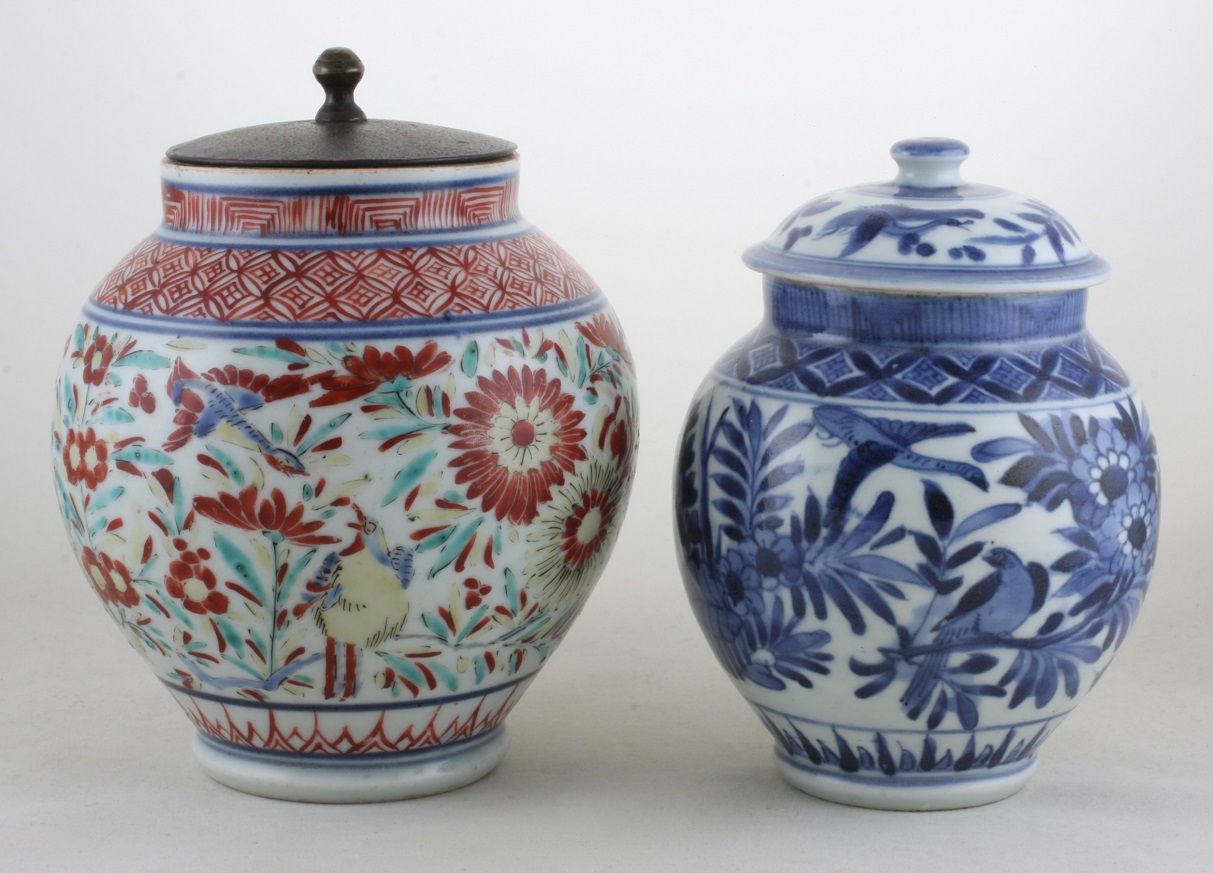
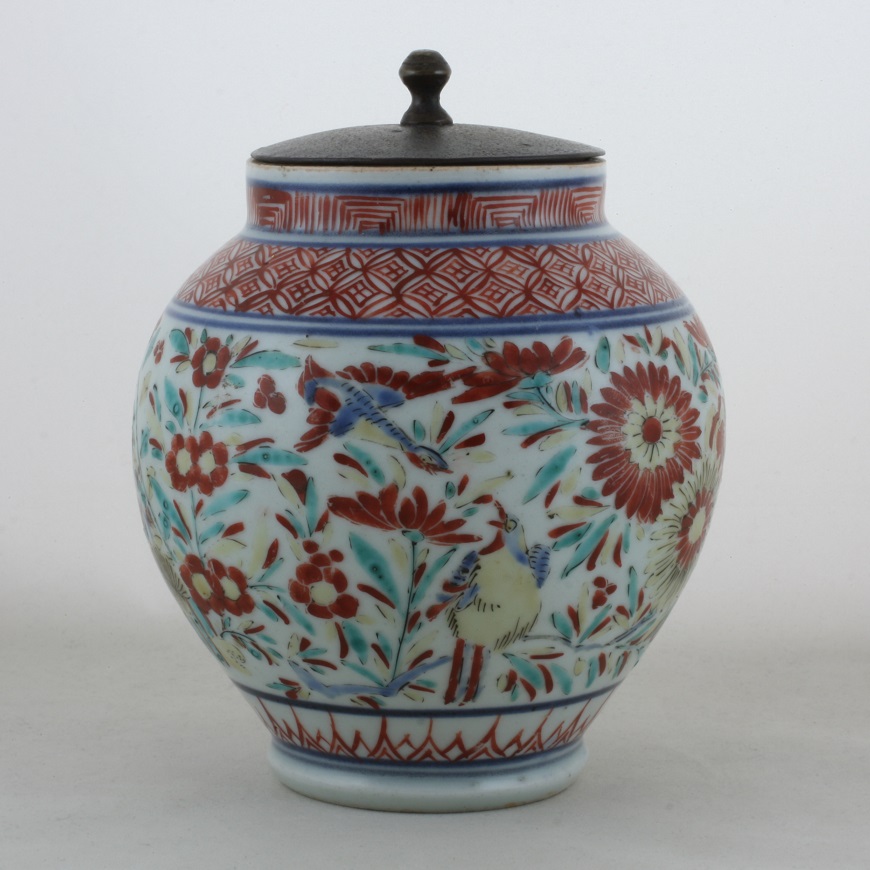
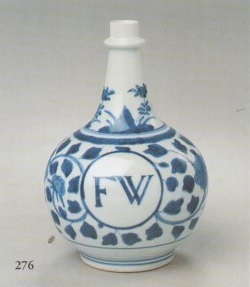
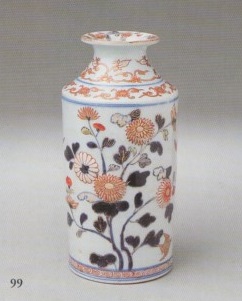
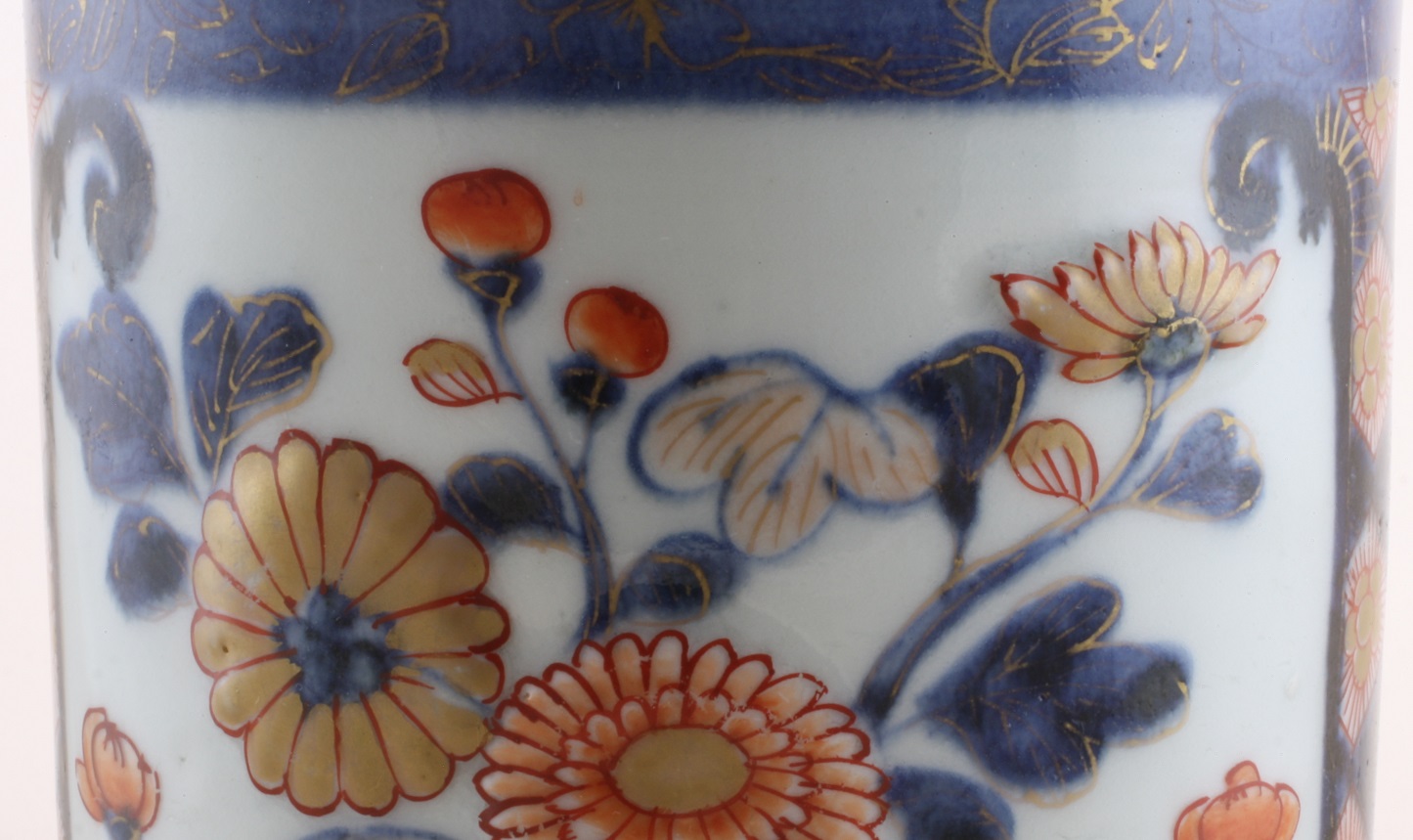
 create websites
create websites